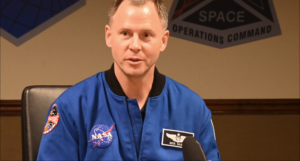First Guardian bound for orbit wants more Space Force astronauts
Space Force Col. Nick Hague is set to become the first Guardian to head to orbit, and he doesn’t want to be the last.
Launching to the International Space Station Sept. 26 aboard NASA’s Crew-9 mission, Hague will pilot a Crew Dragon spacecraft alongside Roscosmos cosmonaut Aleksandr Gorbunov on a mission that’s expected to last into February.
Hague, who first went to space as an airman on a 203-day mission to the ISS in 2019, told The Space Report earlier this year that he wants Guardians to better understand the crucial role they play in human spaceflight, from launch operations to orbital safety.
“The second thing I hope they see is I hope they see themselves; I want to see more Guardians apply to the space program,” Hague said during a visit to Peterson Space Force Base in Colorado.
Retired Air Force Col. Catie Hague, the astronaut’s spouse, said her husband was looking forward the launch.
“Nick is ready to go and excited to represent the men and women of the United States Space Force on orbit,” she said in an email.
Hague, a 1998 Air Force Academy graduate, entered NASA’s astronaut program as an airman and had just returned from a 203-day mission aboard the ISS when the Space Force was created in 2019. He was one of the early officers who joined the Space Force and took a break from his NASA duties to help establish the new service’s test and evaluation program. Ahead of his next launch, Hague worked to show Guardians how their strict standards and attention to detail make human spaceflight possible and “directly support the success” of space exploration.

Space Force Col. Nick Hague is poised to become the first Guardian to reach space when he launches to the International Space Station later this week. Credit: Space Foundation
Hague earlier this year visited Sierra Space outside Denver to train with the firm’s Dream Chaser spacecraft, which is planned to make its maiden cargo flight to the ISS this year. Dream Chaser, a reusable craft similar to the Space Force’s X-37B pilotless spacecraft, is the first commercial winged spacecraft that can land on conventional runways. Hague worked with Sierra engineers to map out how the new spacecraft will dock with the station and learn how to properly load and unload its cargo.
Hague’s first mission to space in 2018 may have been his most terrifying. A booster malfunction sent his spacecraft tumbling before the crew activated an emergency escape system. The Crew Dragon’s automated systems are a big shift from the manual switches and controls used to pilot the Soyuz, Hague said.
While he admires the new American-built spacecraft, Hague is a big fan of the multinational cooperation that made the International Space Station a global asset.
Much of the colonel’s planned mission to the station will test technology for a new generation of commercial space stations expected to launch for low Earth orbit in the next decade. Hague will also help conduct a variety of science experiments in subjects from physics to medicine.
Related Resources
- Nicola Fox on NASA SMD: All the science we do directly impacts civilization
- Experts: Space weather affects us all, regardless of whether we are aware
- Habitable Worlds Observatory mission aims to find answer: Is life unique?
- 2024 Total Solar Eclipse big topic during discussion of NASA’s Heliophysics Big Year